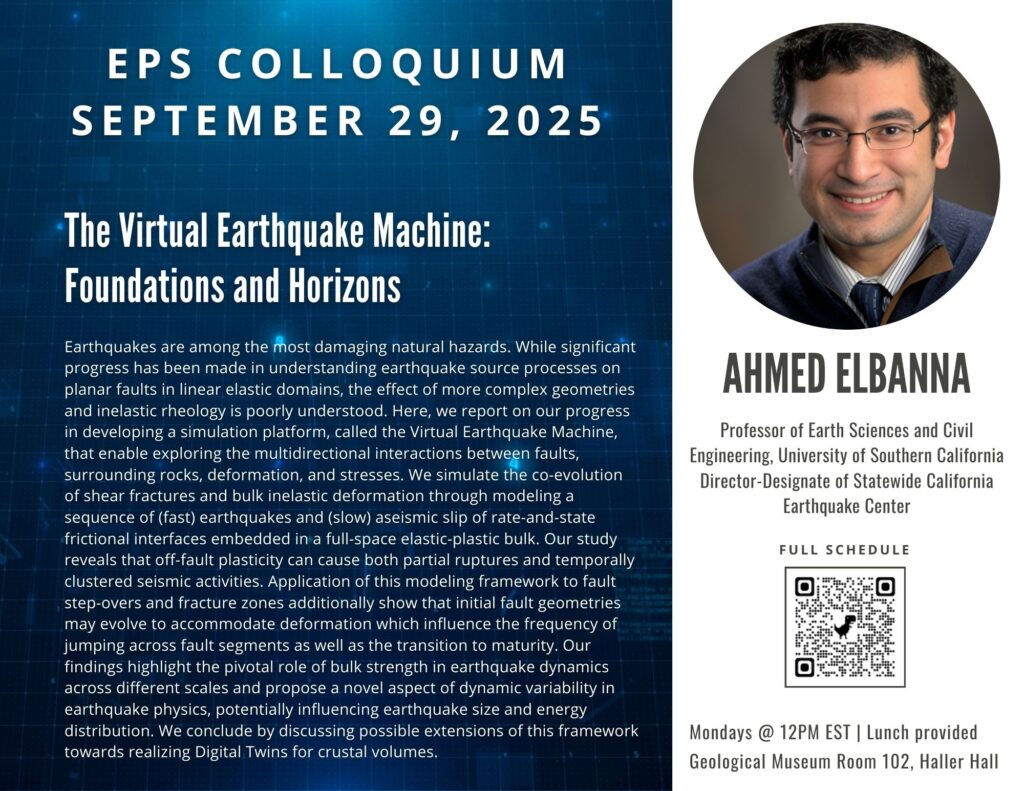EPS Colloquium – Ahmed Elbanna, University of Southern California
The Virtual Earthquake Machine: Foundations and Horizons
Earthquakes are among the most damaging natural hazards. While significant progress has been made in understanding earthquake source processes on planar faults in linear elastic domains, the effect of more complex geometries and inelastic rheology is poorly understood. Here, we report on our progress in developing a simulation platform, called the Virtual Earthquake Machine, that enable exploring the multidirectional interactions between faults, surrounding rocks, deformation, and stresses. We simulate the co-evolution of shear fractures and bulk inelastic deformation through modeling a sequence of (fast) earthquakes and (slow) aseismic slip of rate-and-state frictional interfaces embedded in a full-space elastic-plastic bulk. We use a computationally efficient hybrid finite element spectral boundary integral (FEBE) scheme that relies on domain decomposition in space and extreme adaptive stepping in time. The hybrid computational scheme enables exact near-field truncation of the elastodynamic field allowing us to use high resolution finite element discretization in a narrow region surrounding the fault zone that encompasses the potential plastic deformation. Wave propagation and long range static stress transfer in the exterior half spaces are handled using the spectral boundary integral equation. The adaptive time stepping is based on the maximum velocity jump across the fault surface. The resulting time step varies from milliseconds to days enabling the simulation of both slow deformation and fast dynamic ruptures over multiple earthquake cycles.
Our study reveals that off-fault plasticity can cause both partial ruptures and temporally clustered seismic activities. If the bulk yield stress is high relative to the fault’s frictional strength, the plastic deformation dissipates only a few percent of the total energy budget, plastic strains mainly accumulate during seismic events, and the system fails predominantly in fast events. Conversely, if the bulk’s yield stress is low enough to be comparable to the fault’s frictional strength, new rupture patterns emerge from slow to fast slip. These are marked by increased energy dissipation within the bulk and slow or creeping ruptures on the fault without much noticeable inertia effects. In all cases, the damage zone remains localized near the fault with its width saturating with slip and the amplitude of inelastic deformation decreasing rapidly with distance normal to the fault. Application of this modeling framework to fault step-overs and fracture zones additionally show that initial fault geometries may evolve to accommodate deformation which influence the frequency of jumping across fault segments as well as the transition to maturity. Our findings highlight the pivotal role of bulk strength in earthquake dynamics across different scales and propose a novel aspect of dynamic variability in earthquake physics, potentially influencing earthquake size and energy distribution. We conclude by discussing possible extensions of this framework towards realizing Digital Twins for crustal volumes.
To be added to the EPS colloquium mailing list, please contact Caroline Carr at carolinecarr@fas.harvard.edu


